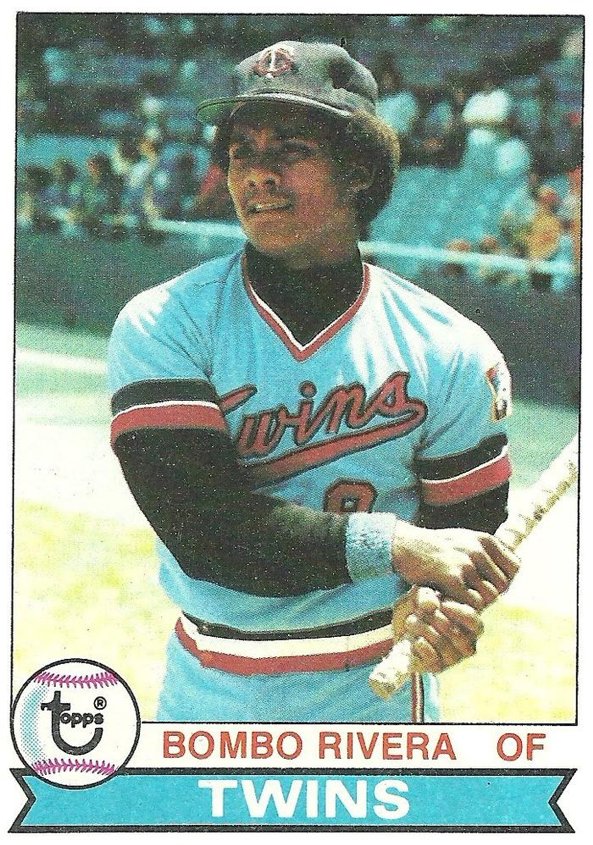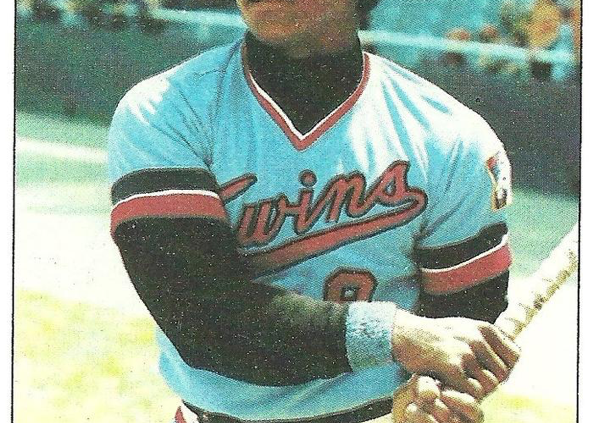July 21, 1979: Rivera’s bomb-o wins it for Twins
 Jesus Manuel Rivera Torres got his memorable nickname, “Bombo,” in honor of the skyscraping fly balls he hit while playing in a children’s league in his hometown of Ponce, Puerto Rico. “They weren’t always long fly balls,” he later recalled, “but they were always high.”1
Jesus Manuel Rivera Torres got his memorable nickname, “Bombo,” in honor of the skyscraping fly balls he hit while playing in a children’s league in his hometown of Ponce, Puerto Rico. “They weren’t always long fly balls,” he later recalled, “but they were always high.”1
In parts of six major-league seasons between 1975 and 1982, Rivera hit just 10 home runs, and never more than three in one season. But one afternoon in July 1979, Bombo hit a ball both long and high for a late-inning, game-winning home run, delighting Minnesota Twins fans who had already taken him to their hearts for his enthusiasm and hustle – not to mention that resonant nickname.
At the start of play on Saturday, July 21, 1979, manager Gene Mauch’s Twins were lurking on the fringes of the American League West Division pennant race. With a 49-42 record, the Twins stood in third place, 4½ games behind the California Angels.2 The team had gotten off to a good start in April with a 13-7 record, then had played more or less at the .500 level in succeeding months.3 After the All-Star Game on July 17, the Twins split two games with the Detroit Tigers; a doubleheader on July 21 marked the start of a four-game series with the Toronto Blue Jays.
Minnesota couldn’t have asked for a better opponent to get their second-half momentum rolling. In their third season after joining the AL as an expansion franchise in 1977, Roy Hartsfield’s Jays had baseball’s second-worst record at 29-66 and were already 33 games behind first-place Baltimore in the AL East. Toronto had lost eight of its previous 10 games, including two of three against the Twins just before the All-Star break. In fact, Toronto’s 4-2 win on July 14 would be its only victory against Minnesota in 1979; the Blue Jays went 1-11 against the Twins that season.4 The two teams made headlines in May for engaging in three bench-clearing incidents during a 16-6 Twins win, also in Minnesota.5
In the first game of the doubleheader, Toronto jumped out to a 3-1 lead after an inning and a half, only to have Minnesota reclaim the lead in its half of the second and march to a 6-4 victory. Twins shortstop Roy Smalley hit his 17th home run, while starting pitcher Dave Goltz improved his record to 9-6 with seven workmanlike innings. Blue Jays starter Phil Huffman fell to 4-11, en route to leading the AL with 18 losses in his only full big-league season. Rivera played the final two innings of the opener in left field, replacing starter Glenn Adams.
The second game matched two once-promising pitchers whose careers were sidetracked by injury. Toronto’s Balor Moore had been a first-round draft pick in June 1969 by the Montreal Expos, who sped him briefly to the majors the following season at age 19. He won nine games in 1972 but never matched that total again. In later years he blamed the Expos organization for rushing him to the majors, mishandling his career, and not believing he had an injured elbow that eventually required surgery.6
Picked up by the Blue Jays from the California Angels for a reported $100, Moore began 1979 in the Toronto bullpen, but was moved to the rotation in early June despite a 6.86 ERA. He’d whittled it down in subsequent appearances, entering the July 21 game with a 2-1 record and a 3.84 ERA.
Starting for the Twins was righty Paul Hartzell, who’d taken an unusual path to the major leagues. In addition to playing on an amateur team in Baltimore, he’d pitched – and studied mechanical engineering – at Lehigh University in Bethlehem, Pennsylvania.7
The Angels drafted Hartzell in the 10th round in June 1975 and, like Moore, he’d reached the majors just a year after being drafted. Hartzell pitched capably for three seasons as a swingman before the Angels dealt him to Minnesota in February 1979 in the trade that sent future Hall of Famer Rod Carew to California. After throwing more than 140 pitches in a 10-inning win on July 1, 1979, three weeks before facing the Blue Jays, Hartzell began to suffer chronic arm pain. He missed much of August, and 1979 was his last full season in the majors. He entered the game with a 4-6 record and a 5.07 ERA.8
With 15,827 fans in the stands,9 the Twins and Blue Jays took the field for the second game. The first three innings passed without any runs. Rivera – a fan favorite who’d received write-in votes for student body president at the University of Minnesota10 – stirred brief excitement in the first when he singled and reached second on an error by Toronto third baseman Roy Howell, one of 20 errors Howell committed that season.11 But Smalley and Ron Jackson, who had replaced Carew at first base for Minnesota, couldn’t advance him.
Baserunning fluffs hurt both teams. Toronto’s John Mayberry was thrown out in the second inning trying to stretch a single into a double, while Minnesota’s John Castino was picked off in the third inning after a leadoff single. Castino hit. 285 that season and shared the AL Rookie of the Year Award with Toronto’s Alfredo Griffin, who didn’t play in the second game after going 0-for-5 in the first.
The Blue Jays went ahead in the fourth inning, starting with a no-doubt leadoff homer to center field by Howell, his ninth of the season.12 One out later, Mayberry singled and stole second on a missed hit-and-run play when no Twin covered second base.13 Second baseman Tim Johnson, who entered the game hitting .108 in 37 at-bats, singled him in for a 2-0 lead. It was Johnson’s first RBI of the season; he finished with six. It was his final major-league season.
Minnesota got on the board in the bottom half, starting with leadoff singles by left fielder Rivera and Smalley. Rivera took third on Jackson’s double-play grounder and scored on designated hitter José Morales’s single to make the score 2-1. The Twins evened up matters in the fifth on a leadoff home run to left field by right fielder Willie Norwood.14 Minnesota put additional runners on second base in the fifth and sixth innings but failed to advance them. In the sixth, Morales lined into an inning-ending double play when Smalley was caught off second.
That gaffe looked as though it would cost the Twins dearly when Toronto rallied in the top of the seventh. Right fielder Otto Vélez walked, and a sacrifice and a groundout moved him to third. Backup catcher Bob Davis, who entered the game hitting .123 with 3 RBIs in 65 at-bats, drove in Velez with a single off Smalley’s glove15 to put Toronto up 3-2.
The score remained 3-2 entering the bottom of the eighth, with Moore still on the mound for Toronto. Catcher Glenn Borgmann drew a leadoff walk, Moore’s only free pass of the game. Rob Wilfong, the 1979 Twins’ top basestealer with 11, ran for him and was sacrificed to second base.16
Rivera, hitting next, unloaded on a slow curve and drove it about 390 feet into the left-field seats to put Minnesota ahead 4-3. It was the only one of his 10 major-league homers that gave his team the lead.17
Rivera’s bombo positioned Hartzell for the win, if the righty could nail down the final three outs in the top of the ninth. He had no problems, getting Vélez and Johnson on grounders and striking out shortstop Luis Gómez to wrap up the win in a tight 2 hours and 1 minute. Hartzell earned his fifth win of the season, and the second-to-last of his major-league career.18 Moore’s record fell to 2-2; he closed the season with a 5-7 record.
After the game, Rivera said he followed his manager’s instructions during his fateful at-bat: “I just took a short swing, like Gene has been telling me to.” Mauch joked that the round-tripper would help Rivera in his noncandidacy for student body president: “He’ll get those extra votes he needed now.”19
Acknowledgments
This story was fact-checked by Madison McEntire and copy-edited by Len Levin.
Sources and photo credit
In addition to the specific sources cited in the Notes, the author used the Baseball-Reference.com and Retrosheet.org websites for general player, team and season data and the box scores for this game:
https://www.baseball-reference.com/boxes/MIN/MIN197907212.shtml
https://www.retrosheet.org/boxesetc/1979/B07212MIN1979.htm
Photo of 1979 Topps card #449 downloaded from the Trading Card Database.
Notes
1 Rory Costello, “Bombo Rivera,” SABR Biography Project. Accessed June 28, 2022.
2 The Texas Rangers were in second place with a 52-42 record, three games back.
3 The Twins went 14-12 in May, 12-15 in June, and 16-14 in July.
4 Toronto’s 4-2 win on July 14 was also the second big-league win and second complete game for rookie Blue Jays pitcher Dave Stieb.
5 Associated Press, “Twins Were Hitting From All Angles,” Rapid City (South Dakota) Journal, May 9, 1979: 35. Two of the bench-clearing fights occurred in the seventh inning, while Balor Moore was pitching in relief.
6 Ian MacDonald, “Balor Moore Remembers Expos and His Mishandling,” Montreal Gazette, July 12, 1978: 58.
7 As of January 2024, 19 players from Lehigh University had reached the major leagues – but only four had made their debuts since 1950 (Craig Anderson in 1961, Hartzell in 1976, Matt McBride in 2012, and Levi Stoudt in 2023). Seven pitchers from Lehigh had appeared in a big-league game as of January 2024; Hartzell is far and away the leader among them in all statistical categories.
8 Thomas Van Hyning, “Paul Hartzell,” SABR Biography Project. Accessed June 28, 2022. In addition to arm pain after the extra-inning complete game, Hartzell later suffered a chronic back injury.
9 Baseball-Reference and Retrosheet both use an attendance figure of 12,887. The Minneapolis Star Tribune’s game story cites an attendance figure of 15,827, “including 2,940 knotholers” – that is, children getting in for free.
10 Rivera received 971 write-in votes for student body president in spring 1979; he didn’t win, but he beat two students who actively campaigned. United Press International, “Bombo Rivera Is Popular,” Olathe (Kansas) News, May 23, 1979: 7.
11 Howell was third among AL third basemen in errors committed in 1979. He’d led AL third basemen in 1976 with 28 errors.
12 “Twins Scorecard,” Minneapolis Star Tribune, July 22, 1979: 10C. This scorecard gave a distance of 423 feet for Howell’s home run.
13 M. Howard Gelfand, “Rivera, Goodwin Power Twins Sweep,” Minneapolis Star Tribune, July 22, 1979: 1C.
14 “Twins Scorecard.” The scorecard said Norwood’s home run traveled 414 feet.
15 “Twins Scorecard.”
16 The game story in the Minneapolis newspaper has Wilfong at first base when Rivera came to the plate in the eighth inning, but Retrosheet and Baseball-Reference say Twins second baseman Bob Randall sacrificed Wilfong to second before Rivera batted. Randall’s sacrifice is also mentioned in Associated Press, “Twins Take Two from Blue Jays,” Lafayette (Louisiana) Daily Advertiser, July 22, 1979: 59.
17 Career summary of Bombo Rivera’s home runs, accessed on Baseball-Reference June 28, 2022. Two of Rivera’s other homers tied the game. Interestingly, six of his 10 homers were hit in the eighth inning, and six were hit at Metropolitan Stadium.
18 Hartzell’s final win came against Baltimore on September 1. He pitched briefly for Baltimore in 1980 and for the Milwaukee Brewers in 1984.
19 Gelfand.
Additional Stats
Minnesota Twins 4
Toronto Blue Jays 3
Game 2, DH
Metropolitan Stadium
Bloomington, MN
Box Score + PBP:
Corrections? Additions?
If you can help us improve this game story, contact us.


